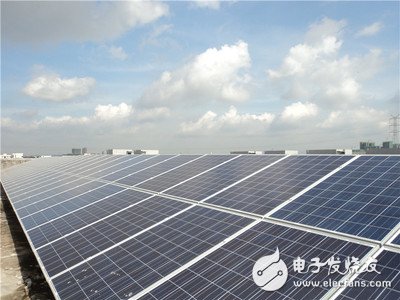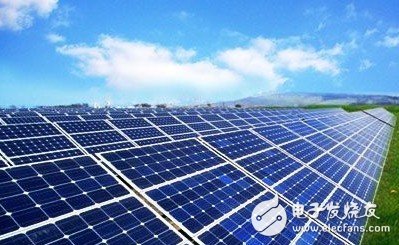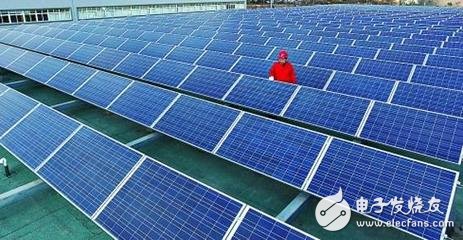Distributed photovoltaic power generation refers to a photovoltaic power generation facility that is built near the user's site and operates in a self-contained mode on the user's side, with excess power on the Internet, and balanced in the distribution system. Distributed photovoltaic power generation follows the principles of local conditions, clean and efficient, distributed layout, and close utilization, making full use of local solar energy resources to replace and reduce fossil energy consumption.
Distributed photovoltaic power generation refers to a distributed generation system that uses photovoltaic modules to directly convert solar energy into electrical energy. It is a new type of comprehensive utilization of power generation and energy with broad development prospects. It advocates the near-generation power generation, the nearest grid connection, the nearby conversion, and the principle of near use, which can not only effectively increase the power generation capacity of photovoltaic power plants of the same scale, but also Effectively solve the problem of power loss in boost and long-distance transportation.

At present, the most widely used distributed photovoltaic power generation system is a photovoltaic power generation project built on the roof of urban buildings. Such projects must be connected to the public grid to provide power to nearby users along with the public grid.
Distributed photovoltaic power generation has the following characteristics:First, the output power is relatively small. In general, a distributed photovoltaic power generation project has a capacity of several kilowatts. Unlike centralized power plants, the size of a PV power plant has little impact on power generation efficiency, so its economic impact is small. The investment yield of a small PV system is not lower than that of a large one.
Second, the pollution is small and the environmental protection benefits are outstanding. Distributed photovoltaic power generation projects have no noise during the power generation process and do not pollute the air and water.
The third is to be able to alleviate the local power shortages to a certain extent. However, the energy density of distributed photovoltaic power generation is relatively low, and the power per square meter of distributed photovoltaic power generation system is only about 100 watts. In addition, the roof area of ​​buildings suitable for installing photovoltaic modules is limited, and the problem of power shortage cannot be fundamentally solved. .
Fourth, it can coexist with electricity and electricity. The power generation of large-scale ground power stations is boosted into the transmission network and operates only as a power generation station; while distributed photovoltaic power generation is connected to the distribution network, power generation and electricity coexist, and it is required to be absorbed as much as possible.

The basic configuration is: solar panels, inverters, brackets, cables and mounting accessories. Large power plants also require other auxiliary equipment such as transformers and power distribution cabinets.
Technical requirements for main equipment of distributed photovoltaic power plants1 photovoltaic bracket
The roof bracket is made of hot-dip galvanized carbon steel bracket, and the assembly is mounted on the aluminum alloy string by means of a back plate or a clamp. The fasteners are made of stainless steel. The bracket is designed to withstand wind resistance of 30 m / s, ensuring long-term outdoor use requirements.
Material and performance requirements:
1) Material requirements: The main material of the selected steel structure is Q235B, and the welding rod is E43 series electrode.
2) Mechanical performance requirements: The mechanical properties of tensile strength, elongation, yield point, cold bending test, etc. of selected steel structural materials shall comply with the relevant requirements of Carbon Structural Steel (GB/T700-2007). Provisions.
3) Chemical composition requirements: The content of chemical elements such as carbon, sulfur and phosphorus in the main material of the selected steel structure shall comply with the relevant provisions of Carbon Structural Steel (GB/T700-2007).
Derusting method and descaling level requirements:
1) Steel components shall be surface treated. The descaling method and derusting grade shall comply with the relevant provisions of the current national standard “Corrosion grade and derusting grade of steel surface before painting†(GB8923-88).
2) Descaling method: steel components can be blasted by blasting or shot peening. If chemical rust removal is used, the treatment liquid with two or more functions of rust removal, phosphating and passivation should be used. It complies with the current national standard "General Technical Conditions for Multifunctional Steel Surface Treatment Fluids" (GB/T 12612-2005).
3) Descaling level: The derusting level should meet the Sa2 1/2 requirement.
Anti-corrosion requirements:
1) Steel members are protected by a metal protective layer. The steel structure brackets are all hot-dip galvanized coating, and the hot-dip galvanizing shall meet the relevant requirements of the technical requirements and experimental methods for hot-dip galvanizing of metal-clad steel parts (GB/T13912-2002), galvanized layer The thickness is not less than 80 μm.
2) Thickness detection of galvanizing: The thickness of the galvanized layer is tested according to the method of "Technical requirements and experimental methods for hot-dip galvanizing of steel-coated steel parts".
3) Hot-dip galvanizing anti-deformation measures: Adopt a reasonable anti-deformation galvanizing scheme to prevent obvious deformation of the components after hot dip galvanizing.
aluminum alloy
a. Material requirements: materials are generally selected 6061 or 6063.
b. Mechanical performance requirements: The quality, chemical composition and mechanical properties of the selected aluminum profiles must comply with the relevant provisions of GB5237.1.
c. The surface treatment shall meet the technical requirements and comply with GB5237.2-2004 "Aluminum Alloy Building Profiles Part 2: Anodized, Colored Profiles".
d. The appearance quality of the profile complies with the provisions of GB5237.2-2004. The surface of the profile should be neat and smooth, and no serious defects such as cracks, peeling, corrosion and air bubbles are allowed.
2 cement foundation
The cement foundation is numbered C30/20 and is subjected to a 20-day maintenance cycle. Dimensions are added to the steel or embedded parts according to the design drawings.

3 photovoltaic components
1. The service life of PV modules under normal conditions is not less than 25 years. The component power standards are strictly in accordance with the relevant requirements of TUV IEC61215 and IEC61730. The standard power of the output power is not less than 80% within the 25-year service life.
2. The power of the single piece of polysilicon component provided cannot be lower than 255W, and the PV module should have a high area ratio power, and the power to area ratio is not less than 143.5W/m2. The power to mass ratio is greater than 12 W/kg and the fill factor FF is greater than 0.70.
3. The components are packaged in Class A standard battery (EL imaging without defects). The upper surface of the battery of the module is uniform in color, no mechanical damage, and there is no oxidized spot on the solder joint.
4. Each cell and interconnect strip of the assembly should be aligned and the frame of the assembly should be clean and free of corrosion spots.
5. No air bubbles or delamination is allowed in the encapsulation layer of the component to form a path between the battery and the edge of the component. The geometry and number of bubbles or delamination should conform to the corresponding product specification.
6. Under normal conditions, the insulation resistance of the component should not be lower than 200M? .
7. The light-receiving surface of the photovoltaic cell should have a good self-cleaning ability; the surface corrosion resistance and wear resistance should meet the corresponding national standard requirements.
8. In the laminate package of EVA, glass, etc., the cross-linking degree of EVA should be 75-85%, and the peeling strength of EVA and glass should be more than 50N/cm. The peel strength of the EVA and the component backsheet is greater than 40 N/cm.
9. The contractor provides the PV module test data, the TUV calibration standard parts calibration test equipment, the test standard S
TC (T = 25 ° C, 1000 W / m 2, AM 1.5).
4 cable
a. Photovoltaic cables must pass the certification of domestic or international certification bodies, and have TUV certification and UL certification;
b. The DC side cable should be selected according to the principle of reducing line loss and preventing external interference. Double insulated UV-resistant flame-retardant copper core cable is adopted. The cable performance meets the requirements of GB/T18950-2003 performance test; Z-PFG type DC cable is recommended. .
c. The AC side needs to consider the form and safety of the laying, and adopts multi-strand copper core fire-retardant cable; the recommended model is ZR-YJVR.
5 inverter
Photovoltaic grid-connected inverters (hereinafter referred to as inverters) are the core equipment in photovoltaic power generation systems and must be mature products with good quality and good performance. The inverter inverts the direct current (DC) generated by the photovoltaic array into single-phase sinusoidal alternating current (AC), and outputs the electric energy that meets the requirements of the grid. The inverter should meet the following requirements:
(1) The power factor and power quality of the grid-connected inverter should meet the requirements of the Chinese power grid. The performance indicators meet the requirements of the State Grid Corporation's “Technical Regulations for Connecting PV Power Plants to the Power Grid†issued by the State Grid Corporation in May 2011.
(2) The installation of the inverter should be simple and has no special requirements.
(3) The inverter should use the maximum power tracking technology (MPPT) of the solar cell module.
(4) The inverters used have been operating safely for more than 3 years.
(5) The inverter is required to be able to operate automatically, and the operating state is highly visualized. The display can clearly display real-time various operational data, real-time fault data, historical fault data, total power generation data, and historical power generation (by month, year-by-year query) data.
(6) The inverter requires automatic fault record data storage, and the storage time is more than 10 years.
(7) The inverter body is required to have a DC input breaking switch and an emergency stop operation switch.
(8) Inverter should have short circuit protection, island effect protection, over temperature protection, AC over current and DC over current protection, DC bus over voltage protection, grid power failure, grid over voltage, grid over frequency, PV array And the grounding detection and protection functions of the inverter itself, and correspondingly give the conditions and working conditions of each protection function (ie, when protection action, protection time, self-recovery time, etc.).
(9) The inverter shall be certified by the national accreditation body in accordance with the requirements of the CNCA/CTS0004:2009 certification technical specification.
(10) The average fault-free time of the inverter is not less than 10 years, and the service life is not less than 25 years.
(12) The warranty period of the inverter is not less than 5 years.
(13) The inverter should have low voltage ride through capability.
6 AC combiner box and network cabinet
(1) The switchgear adopts the standard modular design and consists of various standard units with modulus E=25mm. The units of the same specification have good interchangeability.
(2) All primary equipment and components shall be short-circuited and the thermal stable current shall be able to withstand the dynamic and thermal stable current values ​​of not less than the busbar and shall not be damaged. All electrical components shall be CCC certified and the distribution cabinet shall be fully tested/partially type tested with adequate operational performance.
(3) The main busbar and the branch busbar are made of copper material with high conductivity. When bolted, each joint shall be not less than two bolts.
(4) The rated voltage of the terminal block of the secondary line of the wiring is not less than 1000V, the rated current is not less than 10A, and there are partitions, marking sleeves and terminal screws. Each terminal block should be numbered.
The conductors of the control circuit shall be insulated with a voltage of not less than 1000V. Except for the lead wires of the secondary inserts in the power distribution cabinet, 1.5mm2 strands of copper strands shall be used, and other conductors shall be stranded copper strands with a section of not less than 2.5mm2. Both ends of the wire shall be numbered. The position of the terminal block should be considered convenient for disconnecting the wiring and leave a spare amount of 20%. The terminal block should be made of flame-retardant terminals.
(5) Selection of main components
Frame circuit breakers, molded case circuit breakers, contactors, thermal relays, etc. use international and domestic quality products and have domestically certified products. Choose high-quality components such as ABB circuit breakers and Phoenix lightning protection devices.
The frame circuit breaker has its own intelligent protection unit configuration; the protection unit has perfect three-stage protection and upper and lower level coordination functions.
Feeder molded case circuit breakers should use electronic trip units or thermomagnetic electronic trip units.
All control and display components in the switchgear such as: selection switch, button, indicator light, relay, current transformer, etc. should use high-quality products with operational experience.
7 photovoltaic construction materials
1. Bridge:
The screws used are all in the stainless steel series or measures are taken to prevent rust. The thickness of the zinc layer shall not be less than 65 μm for the sheet below 5 mm, and not less than 86 μm for the thick plate.
2. Lightning protection grounding flat iron
The flat iron parameters used were 25*4 mm and 4*40 mm hot-dip galvanized flat iron for welding.
3.PVC power sheathed pipe
Mainly used for cable laying on the PV AC side, the fixed sheath tube used is made of stainless steel 304 screws.
4. Screws, nuts, nuts
The materials used are made of 304 stainless steel for fixed strength and rust prevention.

UCOAX specializes in custom drawing, flattening, stranding and insulating, cutting and stripping of fine wire and cable .0009" (AWG #48) and larger.
UL iQ for appliance wiring materials
Single-Conductor, Themoplastic Insulation
1007 1015 1061 1185 1126 1227 1330 etc.
Multiple-Conductor, Thermoset Insulation
2464 2468 2725 2835 2990 20276 20379 21100 21118
Single-Conductor, Thermoset Insulation
3173 3265 3266 3271 3272 3302 3346 3347 3363 3383 3385 3386 3619
For more details, please feel free to contact us, thank you.
Ul Wiring Material,Ul Wiring Material Components,Electrical Wire Materials,Wiring Material
UCOAX , https://www.ucoax.com
